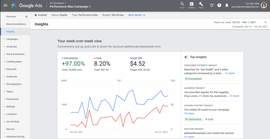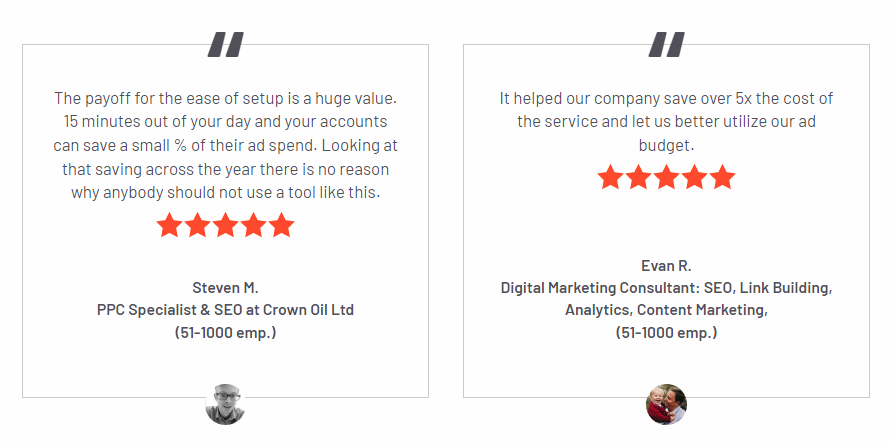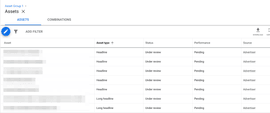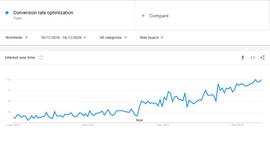Performance Max and smart targeting are here to stay. So how can you use these advancements in AI and machine learning to drive greater revenue growth?
In our latest webinar, we spoke to Google Ads specialists Bob Meijer and Miles McNair about how to get the most value out of Performance Max campaigns and other smart targeting systems. Bob and Miles were joined by Leonardo Pizarro, Head of Demand Generation at Lunio, and the session was hosted by our Content Manager, James Deeney.
Combined, Bob and Miles have over 10 years of PPC experience, worked for more than 200 clients, and profitably spent over €100M on Google Ads. Unlike agency owners or ‘gurus’, the pair actually manage Google Ads campaigns every single day. And everything they teach is based on real, practical experience.
Listen to the conversation or read the summary below to learn how to set yourself up for success and maximise your return on ad spend with Performance Max.
Webinar Timestamps
- 00:00 – Intro & agenda
- 04:53 – First impressions of Performance Max and smart targeting
- 15:30 – What marketers should know about Performance Max campaigns
- 20:00 – Common challenges with Performance Max campaigns
- 25:45 – Best practices for getting started with Performance Max
- 33:15 – Problems with fake clicks & traffic contaminating campaign data
- 36:30 – Strategies to increase the accuracy of conversion tracking data
- 38:20 – Optimising Performance Max bidding strategies
- 42:00 – Performance Max and future of paid media automation
- 49:00 – Outro and access to free resource hub
TL;DR
- Performance Max is still in its infancy. Definitive best practices are not established yet. But it will surely continue to get better with time, similar to previous Google products (e.g. Smart Shopping). This is the new direction for PPC & early adopters have an advantage.
- Always retain a degree of manual input and oversight over any smart targeting or bidding system you’re using to avoid runaway ad spend inflation.
- The two main problems with Performance Max are a lack of insights (i.e. you often don’t know where your ads are showing up or to whom) and the lack of control (i.e. some functionality can only be accessed via Google Reps, bidding strategy can only be set at campaign level giving less granularity over target ad spend).
- Ensuring you have highly accurate conversion tracking methods in place is the single most important prerequisite before using Performance Max. Set up Enhanced Conversions through Google Tag Manager. And look into third party tools such as ProfitMetric’s “Conversion Booster” to sync offline conversion data with Google.
- Before using Performance Max, put a click fraud prevention system in place to prevent non-human / zero-value traffic inflating ad spend and contaminating the buying signals you’re feeding into the algorithm.
- Keep your campaign structure simple. You need to keep enough data within each campaign to allow the algorithm to optimise bids properly. Only segment out into a new campaign when you have a very good reason to do so.
- Use the Asset detail report to assess the performance of each individual asset you’re using. Modify or replace any underperforming assets. Optimise all assets for mobile.
- Performance Max only has two bidding strategies, Maximise Conversions or Maximise Conversion value, with a target CPA or a target ROAS. Have a firm grasp of your break even numbers and determine your risk appetite before setting your bid strategy.
- Test, test, test. Don’t blindly copy what someone is telling you to do because it’s working for them. Run your own Performance Max experiments to find what works for your business. There is no one-size-fits all set of best practices.
- Widespread use of automated targeting and bidding systems means the role of PPC specialists will change significantly in the coming years. Things like ad copy, image generation, and conversion rate optimisation will become the primary focus.
First Impressions of Performance Max & Smart Targeting
Performance Max is certainly causing a stir within the PPC community. But many marketers aren’t that enthusiastic about adopting it. And some hesitancy is completely understandable.
Bob and Miles both mentioned the fact that Google’s track record doesn’t inspire a lot of confidence, especially in the early stages of a new product launch. There are always some teething problems to be ironed out. And this was definitely the case for older automated features such as Smart Bidding, Broad Match, Universal App Campaigns, and Smart Shopping.
But Miles was quick to note that product improvements tend to happen quite rapidly as adoption rates grow. And he’s already witnessed a big change in results generated by his Performance Max campaigns:
“In the beginning it often feels like new products aren’t really finished yet. But once Google gets access to more data and feedback from users, they ‘magically’ start to perform better. And that’s what I saw with Performance Max. I started testing it in beta and wasn’t very impressed with the results at first. But they’ve already gotten a lot better since then. And it’s the same for the campaign insights, Google seems to be releasing new small additions every week”.
So while Performance Max has its issues, it’s only going to get better. And that means early adopters have a significant advantage.
“It’s clear this is the new direction for PPC. And there’s no point trying to fight the system. None of my concerns are going to alter Google’s course. So you need to learn how to leverage the new system to get the best results” said Miles.
Whether we like it or not, automation is here to stay. And outside the world of Google, other ad platforms are continuing to develop their own smart targeting systems. For example, Facebook has recently been pushing its new “Advantage+” campaign type.
“It’s essentially a simplified campaign type with very limited targeting and bidding functionality. It primarily relies on historic conversion data to optimise who it targets. And at Lunio, we’ve already seen some great results using lookalike audiences based on people that have previously converted on older ad campaigns” said Leo.
But Leo also pointed out some platforms are ahead of others when it comes to smart targeting. In particular, he advised being wary of LinkedIn’s current offering:
“Currently, if you set up an automated campaign on LinkedIn and let it bid whatever it wants, you could be paying up to $100 or even $200 per click. So you definitely need to be cautious when testing these systems and you should always aim to have reliable manual input and oversight in place”
The Cons of Performance Max Campaigns
Bob cited two main challenges he’s encountered with Performance Max so far:
- Lack of insights
- Lack of control
As Miles mentioned, the insights available through Performance Max are getting broader every week. But that doesn’t change the fact a lot of important elements are still missing. And as Bob explained, this is a bone of contention for many PPC specialists.
“Currently, you can only monitor the search categories and audience segments your Performance Max campaign is delivering within. That gives you a rough idea of where your ads are showing up and the kinds of people Google is presenting them to. But there is so much missing.
“You can only see week-on-week or month-on-month results within the insights tab. Miles and I would both like to see some kind of data selector within the campaign type, so we can see results over longer and shorter periods. For example, if you want to see what kind of search categories you were found for 2 months ago, that’s not possible
“We’d also love to see the split between Search, Display, Discovery, YouTube and Shopping. This is a huge missing piece. It’d give us a lot of extra helpful insights, but we’re not hopeful that Google is going to add it anytime soon” said Bob.
When it comes to lack of control, similar problems exist. Of course, automation always requires giving up some control. But many Performance Max users are becoming frustrated by the hoops they have to jump through to set things up the way they want.
“In order to add negatives to your campaign you currently have to go through a Google Support Rep. You need to get on a call and ask them to add certain negatives on your behalf. If that functionality exists, you surely should be able to add them on your own” said Bob.
In other cases, the required functionality doesn’t exist at all. Performance Max doesn’t yet have the level of granularity needed to fully optimise for all relevant campaign variables.
“The only way you can set a bidding strategy is on campaign level. So if you’re working with multiple assets for different services or product categories, you are essentially saying ‘this is my target for all of my asset groups’, which is far too broad in my opinion.
“For example, if you’re a car mechanic selling window repairs and oil changes, these services have different lifetime values and acquisition costs. So you should be able to bid differently for them. But that’s not an option right now” said Bob.
5 Best Practices for Optimising Performance Max Campaigns
Performance Max is still relatively new and continues to change on a weekly basis. So it’s impossible to give a definitive set of best practices that will work for all businesses. That said, there are still plenty of things you can do to set yourself up for success.
Throughout the webinar Bob, Miles, and Leo made several recommendations to help drive more conversions and revenue. We’ve organised these into five categories and expanded on each one below. Some of the tips apply specifically to Performance Max campaigns, while others are broadly applicable to any Smart Targeting system.
- Conversion Tracking & Data Input
- Filtering Out Fake & Invalid Traffic
- Campaign Structure
- Asset Optimisation
- Bidding Strategies
1. Conversion Tracking & Data Input
This point kept coming up again and again throughout the webinar. And with good reason. When working with an automated targeting system, the principle of ‘garbage in, garbage out’ always stands. So if the conversion tracking data you’re feeding into the algorithm isn’t up to par, you’re inevitably going to see lacklustre results.
“I think the single most important point to focus on with Performance Max or any other Smart Targeting system is your data input. That input is being used by the algorithm to predict a specific end result, which is your conversion. And a conversion is different for every business and every account”
“So make sure you understand what your goals are from the outset, and you can actually steer on those goals with your conversion tracking. Before getting started, do as much as you possibly can to ensure your conversions are being logged correctly” said Miles.
Following on from this point, Bob outlined some specific tools and strategies you can use to get more accurate conversion tracking data.
“Firstly, Google has features to help with this. So if you haven’t done so already, make sure you set up Enhanced Conversions”
Enhanced Conversions turns first-party personal information from visitors on your site (such as names and email addresses) into hashed text before sending it on to your Google Ads account. This means if they leave your site and return at a later date to make a purchase, the conversion can still be attributed back to the original ad the user had clicked on to get to your site.
But Bob also recommended implementing further conversion tracking best practices.
“A platform I regularly use is ProfitMetrics.io – they’ve created a feature called ‘Conversion Booster’. It combines Google tech with offline conversion tracking. If a conversion pixel cannot be fired because of ad blockers, or because the order success page didn’t come up, then there’s a backup offline conversion tracking method in place… essentially this means you have a way of recording conversions you’d otherwise miss
“By leveraging these kinds of tools for my clients I improved my conversion insights by as much as 20%. That’s huge when you’re using Performance Max. It gives you additional conversion volumes the algorithm can learn from to better optimise its bids.”
One final point to be aware of when it comes to conversion tracking is the way Performance Max logs conversions in the insights tab. It includes actual conversions, and expected conversions based on the last seven days of campaign data.
“For example if it says you’ve got 50 conversions, you might only have 40 and Google is adding in another 10 because they think people are going to convert later on” said Miles.
2. Filtering Out Fake & Invalid Traffic
Based on data we’ve collected at Lunio, we commonly see around 10 – 20% of ad spend is wasted on bots and fake users on ad platforms like Google. Which is something you should always take into account if your campaigns are failing to meet your conversion targets.
Leo explained that fake clicks and traffic can end up causing significant data discrepancies.
“You might go into Google Analytics and review your click and conversion data there. Then you log into your CRM and see completely different metrics. Different click volumes. Different conversion volumes. Different values per lead. And this is in part due to the distorting influence of fake and invalid traffic on your ad campaigns”
To minimise these kinds of data discrepancies and ensure you only pay for clicks from real humans with genuine conversion potential, it’s worth putting a click fraud solution like Lunio in place.
Lunio uses machine learning to instantly determine the legitimacy of each and every click on your PPC ads. If a click is identified as coming from a bot or fake user, Lunio blocks that user from seeing any of your ads across all networks. If a click comes from a real customer, they’ll continue seeing your ads on all platforms they use.
The details of all fake and legitimate clicks logged as first-party data in real-time, providing useful insights into the key differences between converting and non-converting traffic.
3. Campaign Structure
Unlike Smart Shopping, Performance Max allows you to create multiple Asset groups per campaign. This opens the door to having a single campaign, but building out multiple assets groups to target different parts of your product catalogue. But what’s the right approach?
During the webinar, Miles laid out his ‘4 Golden Rules’ for Performance Max campaign structures.
- Keep it simple.
- More data is better – try to keep as much data as you can inside one campaign because the algorithm then does a better job of optimising for your goals.
- Only segment out, or create new campaigns when you have a really good reason to do so, as this fragments data and can hinder performance.
- Test, test, test. Don’t copy blindly what someone is telling you to do because it’s working for them. Run your own experiments to find what works for your business.
As mentioned previously, data is everything when it comes to automation. So to make your strategy work, you need to ensure you’re keeping enough data within each individual campaign to allow the algorithm to meaningfully optimise your bid strategy.
“For example, in eCommerce I typically use a structure where you’ve got two or three base layer campaigns segmented by value for your business. High value products are grouped together in one campaign. And low value products are in another.
“On top of that, you can then layer on additional ‘building block’ campaigns for things like your best sellers or seasonal products you want to push within a given time period” said Miles.
4. Asset Optimisation
Besides grouping multiple assets together, you can also improve the individual assets within each group. Google automatically evaluates all your text, images, and videos and gives each asset one of four values:
- Low: low performing against all other assets of the same type across properties.
- Good: assets perform well enough
- Best: one of the highest performers of all assets
- Pending: not enough data yet (you’ll need > 5000 impressions per asset)
Getting into the details of creative best practices is beyond the scope of this webinar. But Miles gave some top-level suggestions to boost asset performance.
“Always tie your ad copy to the product and the image / video you’re using. Google is going to combine your headlines and images and put them anywhere they can, so they need to be tailored to your specific product or service. Make sure your product is always very central in any images you’re using to avoid display issues. And don’t forget to optimise everything for mobile too, as sometimes that goes overlooked”
5. Bidding Strategies
Automated bidding strategies are very limited with Performance Max. You can only select Maximise Conversions or Maximise Conversion Value, with a target CPA or a target ROAS. As a result, Miles stressed the importance of having a firm grasp of your figures from the outset.
“It’s still surprising to me how many brands don’t know their numbers. What is your break even ROAS? What is your break even cost to acquire a new customer? Is your first sale more valuable because you can upsell more on the backend? Or is your first sale typically less valuable than the ones that follow?
“These are the kinds of questions you need answers to. If you know your numbers inside out, you can translate them into concrete goals within Google Ads.”
Secondly, you need to know your risk appetite. And this will vary significantly from company to company depending on budget availability.
“There’s always a learning phase with any smart bidding strategy. And basically, the more budget you have, the faster you can progress through that learning phase, because you can get a lot more conversions in a short timeframe.
“Some brands have a lot of money and are willing to spend it on learning as fast as possible. But other brands have very little, and their risk appetite is super low. So this needs to be factored into the bidding strategy you’re using”
In short, know your numbers, work out your risk appetite and go from there.
The Future of Performance Max & Paid Media Automation
To wrap up the webinar Leo, Bob, and Miles shared their own opinions on where they see paid media automation heading in the coming years. For Leo, the future lies in AI-generated images and video.
“Over the past few years, most ad platforms have been shifting towards more of a visual impact. Search ads now use image and video assets. And Facebook is pushing advertisers to lead with video wherever possible, even giving you the option to add audio to any images you upload.
“We’re seeing this with programmatic display as well. If you compare the performance of static display ads to dynamic ones in which the elements change when you hover on the ad, dynamic usually wins. So I think over the next few years, we’ll see advertisers using tools to deliver AI-generated images, videos, and animations to the right audiences at the right time”
For Bob, increased automation means PPC specialists need to step up their game.
“Automation levels the playing field for all advertisers. Imagine it’s 2024, and everyone has moved to Performance Max campaigns. In that environment, how do you make sure you stand out? What can you do to get the edge over your competitors?
“For me, the automation of targeting and bidding means things like ad copy, image generation, and landing page optimisation are becoming even more important. I don’t think PPC specialists have to fear for their jobs. But the work they do in 2024 will be very different from what they’re spending most of their time on today.
“Personally I’m already starting to dive deeper into stuff like ad copywriting and conversion rate optimization (CRO). Because I think that will be a huge chunk of my work in the near future.”
And for Miles, recent changes seem to point towards a potential “keywordless” future.
“Attribution is always difficult, but it’s going to become even more important as we steer away from keyword targeting and keyword bidding as we know it. Especially when you consider we’ll likely eventually lose third-party cookies too.
“We’ve already lost the original iteration of keywords because of things like close match variants and broad match. Exact keywords are not exact anymore. And that means we need to put more focus on the actual person behind the search.”
Want to hear more from Bob, Miles, and Leo? Watch the full-length webinar here.
Useful Links & Free Resources
All webinar attendees were sent free resources after the event which you can access below:
Free Resources for Performance Marketers
- Lunio’s Ultimate List Of 60,000+ Display Placement Exclusions
- Miles’ PPC Hub: Free Discord Community for Google Ads Specialists
- 100+ PPC Memes (Created by Bob & the Discord Community)
- A Guide to Advertising in a Privacy-First World 2022
- And more!
Performance Max Mastery Course, Led by Bob Meijer & Miles McNair
Conversion Booster (offline tracking data sync), ProfitMetrics.io
How to Set Up Google Ads Enhanced Conversions, Google










